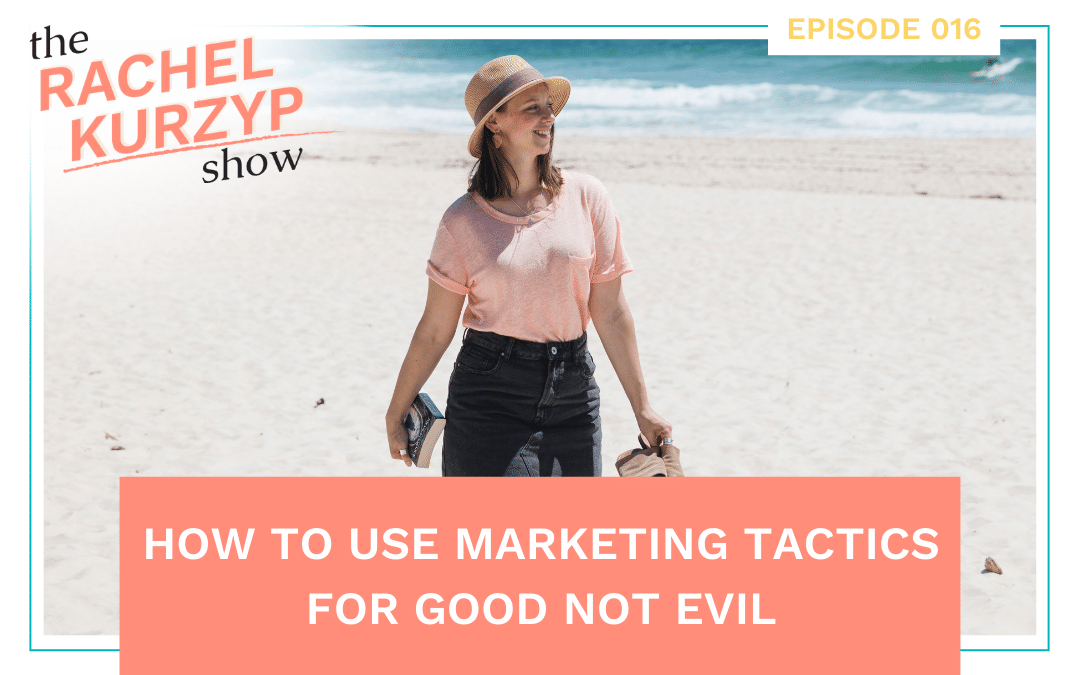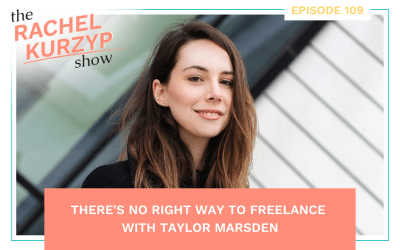Welcome to The Rachel Kurzyp Show
You’re listening to episode 16.
Today I want to chat more about ethical marketing – specifically 4 tactics that have been criticized this year: charm pricing, countdown timers, bonuses and post-it note walls.
If you’ve be wondering what they are, how they are used, and what you need to consider before implementing them in your business, then this episode is for you.
While I think we can all agree strategies like incorrect use of trigger warnings, manifest money messaging and telling people they need to buy a service or product otherwise they won’t be successful are unethical and should never be used. I talk about these in detail in episode 2.
Things become greyer when we look at specific marketing tactics on their own. And this is what I want to focus on today because I’ve had many conversations recently with my clients, peers and the wider community about whether certain tactics are unethical.
These conversations are important and I’m glad we’re having them because there is a lot of things that need to change in the business world.
Bro marketing as it’s been called is gross, sleazy and unethical. It’s the reason why so many of my community shy away from using marketing and sales tactics in their business. As result, most of the marketing we see and is used on us is some form of bro marketing. So we believe this is the only way we can build successful and profitable businesses.
I want to change this. You can market your business in a sustainable and purposed-led way. I believe that it’s the combination of tactics and the overall strategy that determines whether a business is being unethical. NOT necessarily the tactics themselves. And I’ll explain this more in a moment.
Before I dive in, I want to premise this episode by saying that these are my opinions. You may or may not agree with them. And that’s completely OK.
My hope by sharing my thinking around these tactics and how I use them in my business is that you can make decisions that are right for you and your business AND do your own research and investigation.
Just like you, I’ve done a lot of unlearning this year and I’m spending a lot of time looking at my approach to marketing and how I want to show up, serve and sell to my community.
This means I reserve the right to change my mind and if you’re listening to this episode later, I may have changed my opinion and no longer by using these marketing tactics in my business.
So let’s dive in and look at the marketing tactics that have come under fire this year.
Charm pricing
Charm pricing, also known as psychological pricing, is a pricing strategy that uses odd numbers—often 5, 7 and 9s—to influence perceived value and convince customers and clients to buy. We read left to right so when we see a product for $99 we perceive it to be closer to 90 not $100.
This goes the other way too. If you want to make your offer look premium, science says you should end your price in a zero. So if you’ve ever wonder why everything at the grocery store is $1.99 this is why and the same goes for digital products in the biz world. That’s why we see so many $27, 49 and 99 products.
I’ve used whole numbers and charm pricing and I’ve tested out both extensively this year. I’ve decided to use whole numbers from now on for three reasons. Using whole numbers doesn’t appear to affect my conversions (however, I’ve yet to test this out with the sale of my course which is increasing in price from $495 to $700 AUD), I want my services and products to be perceived as premium (because they are) and I know a small number of my clients have stated they prefer not to use charm pricing themselves.
So should you go and change all your prices to whole numbers? I don’t believe you need to unless you want to OR it makes sense for your business. Why? Well pricing is psychological and will always involve some level of strategy. We are never going to be able to change that. But we can change and control the way we talk about our offers. And I believe you should spend time looking at your messaging, promises, payment plans and refund policies instead. The focus should be on the customer experience as a whole.
Countdown timers
You’ve probably seen colourful clocks counting down at the top of webpages and emails. Countdown timers are a visual way of creating and showing urgency. They are often used to encourage people to take action and purchase before doors close or a bonus ends.
People often misuse them to create fake urgency. For example, encouraging people to buy a course or product in a short amount of time like 20 minutes before the offer disappears forever. However, the offer is then presented to the customer again the next time they click a button and the next. Therefore creating fake urgency. This a bad marketing tactic which I don’t recommend and personally see as unethical.
BUT I don’t believe countdown timers are bad. I have used them on my sales pages for special OTO which really are OTOs. And I have used them in my emails to let people know that doors are closing on my course soon. I use them strategically and sparingly and I believe they can actually be beneficial to the customer, letting them know that if they are interested they should reach out to me. Clients have even thanked me for the final reminder. Again, they need to be used within a wider marketing strategy and not use incorrectly to scare people into buying.
If you’re not sure whether you should use them, ask your community if they would find them useful or off putting. And think about the times you’ve seen them in marketing you’ve engaged with. How did it make you feel? Don’t be afraid to ask the hard questions and then act accordingly.
Bonuses
Human beings don’t like taking action until the last moment, so bonuses are a great way encourage and reward people for joining a program or course or buying a product. Additional resources, templates, swipe files or 1:1 calls are often used as a fast action bonuses -which normally last 24-72 hours. Bonuses can also be used to increase the perceived value of a service program or product and offset the price making it feel more attractive.
Many business owners are extorting this factor, much like you can do with charm pricing, and overwhelming people with value. You may have seen statements like total value $19,997 yours today for $197 and spent 5 minutes scrolling through the list of irrelevant bonuses on a sales page. This in my opinion is an unethical marketing tactic because they are overwhelming the customer with information and trying to make it look the purchase is a ‘no brainer.’ And often the offer itself, isn’t particularly good and is only appealing with the 30 or so bonuses.
Again, I think using bonuses in the right way can be a great tool to help your dream client take action. I use bonuses in my launch strategies, but I see them as just that – a bonus. They don’t take away or distract from the main offer. I see them as an entrée – that is something that will help my client bridge the gap between where they are now and where they need to be to experience the full transformation of my offer.
Or as a desert – something my client wants on top of the service or program that will support their next step. And in the last few months I’ve been trialling assigning financial values to them. To be honest, I haven’t decided if I will keep the dollar value or not. I don’t believe its unethical to do so, I just have figured out the twist I want to add to it yet. This is something I will be looking into more in 2021.
If you’re thinking of using bouses, stick to 1 or 2 and think carefully about how and where you can add value. See it as one important part of your customer’s overall journey and experience working with you. Not an add on or after thought.
Post-it note walls
The post-it-note phenomenon came about because people wanted to have a visual way to welcome and celebrate people joining their course or program. And it also acts as social proof – if 45 other people have enrolled, maybe I should to. Social proof such as testimonials, DM screenshots and numbers e.g. 45 people are a great way to help overcome objections and show that you can do what you say you can.
Unfortunately, post-it-notes have become so common that I believe they have lost their impact. And this tactic combined with other grey-area tactics or clearly unethical tactics means that the post-it-note wall feels more like a trophy wall or something out of American Pie and it’s now more about the business owner and what they’ve achieved or made in profit and less about the people who have chosen to invest in them.
I’ve never done this myself because this tactic doesn’t sit well for me. BUT I have and will continue to do my own version of this. For example, I do silly happy dance boomerangs and give people shout outs and I also share stories talking about how amazing my coaching clients are and encourage others in my community to support and follow them. This feels better to me because the focus is on my client but it’s still acting as social proof and shows the connection between my clients, me and my programs.
Like with anything in your business, find a way make the tactic work for you and your values. Add your own personal twist and invite your followers to participate. Remember: marketing is a two-way conversation so if the convo feels one-sided, something is out of alignment.
OK there you have it. A look at 4 marketing tactics and how they can be used for good or evil.
If you take away anything from this episode, I hope it’s the importance of learning and understanding the marketing tactics available to you before using them. Don’t do something just because everyone else is.
Thanks so much for tuning into today’s episode.
If you’ve found what I’ve shared valuable please leave a review and hit the subscribe button so you don’t miss when a new episode drops every Wednesday.





